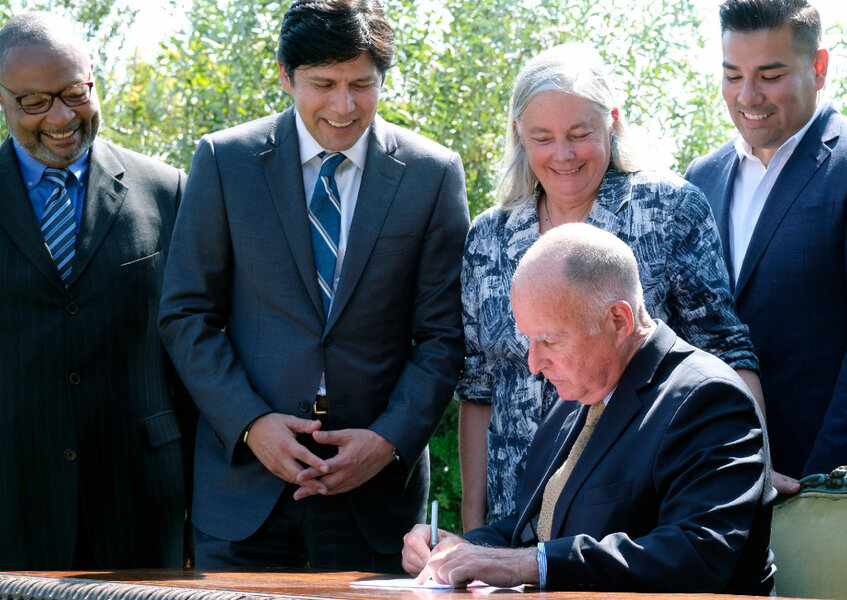Could California's emissions-cutting law pave the way for other states?
Loading...
With new legislation that demands another sharp cut in emissions, California Gov. Jerry Brown hopes to “send a message across the country.”
The bold efficiency goals could inspire other states and nations to follow suit, especially as California's clean-energy companies are already contributing to the state's strong economy, which is growing a third again as fast as the national economy.
California's previous emissions-reduction commitments called for cutting state greenhouse gas emissions to 1990 levels by 2020. The new plan, taking shape in two laws signed by Governor Brown on Thursday, mandates that California reduce its emissions by 40 percent from that 1990 benchmark by 2030.
One of the bills, SB32, lays out the emission limits, while a companion bill, AB197, gives state legislators more oversight as California engineers pursue the new goals.
According to the state senate, the current regulations have already saved Californians money by cutting their energy bills and costs of transportation.
California has a history of taking the lead on climate issues. After then-Gov. Arnold Schwarzenegger signed a 2006 law sharply limiting emissions, several other states – including New Mexico, Arizona, and Vermont – quickly followed.
Brown says he hopes other states and nations will again follow in California's footsteps.
"The real source of climate action has to come from states and provinces," he told the Climate Change Summit of the Americas in 2015. "This is a call to arms. We're going to build up such a drumbeat that our national counterparts – they're going to listen."
In some respects, California's climate initiatives show it behaving like a nation itself. Brown spoke at the Paris Climate Conference in December, where his state was praised for its pioneering efforts to meet emissions targets. Its economy – which would likely be the sixth largest in the world, if California were an independent country – and its population, almost 40 million, make it a reasonable model for many nations.
Will the rest of the US echo California’s intensified commitment to emissions cuts? Climate impacts may suggest an answer. Wildfires and persistent drought have hit California hard for several years, and now other states are beginning to experience climate change-related natural disasters, such as the severe flooding in Louisiana and West Virginia.
The climate is not the only issue at stake, however – and regulation is not always met with enthusiasm. A similar law was defeated last year in California, opposed in part by industries protesting that it was too much change, too soon. One Republican in the state legislature has dubbed it the "Energy Poverty Act of 2016," as The Wall Street Journal reports.
Overall, however, California's economy may suggest that protecting the climate can be good for business, too. It not only has the largest economy in the nation but also the fastest growing, expanding by 3.3 percent last year, though the national GDP grew only about 2.4 percent, Bloomberg reported in June. Traditional-energy producers like Alaska and Montana, by contrast, saw their GDP contract last year.
California's clean energy companies invest almost twice as much of their revenue into research and development as companies in the rest of the country, Bloomberg reported — and those companies consistently outperform those outside the state.
Research suggests that a transformation like California’s may be possible for other states, but it won't be cheap. With a $200 billion annual investment until 2035, the United States could transition to a clean energy economy, according to one report by the Center for American Progress and the Political Economy Research Institute at UMass-Amherst. Their program involves retrofitting buildings to increase energy efficiency, a legally-binding carbon cap, and tax credits for clean energy production. The researchers say that the process would also add 2.7 million new jobs nationwide.
"The single biggest lesson [from California] is that if you turn the dial up on climate change policy, you can also see tremendous economic benefits," Derek Walker, an associate vice president on global climate for the Environmental Defense Fund, told The Christian Science Monitor last December. "It's not a trade-off."







